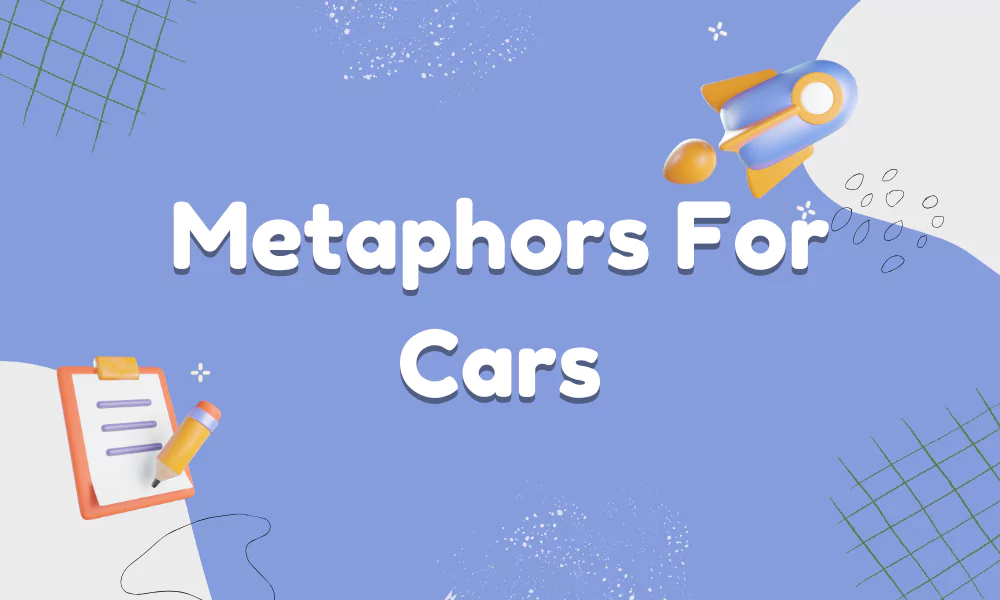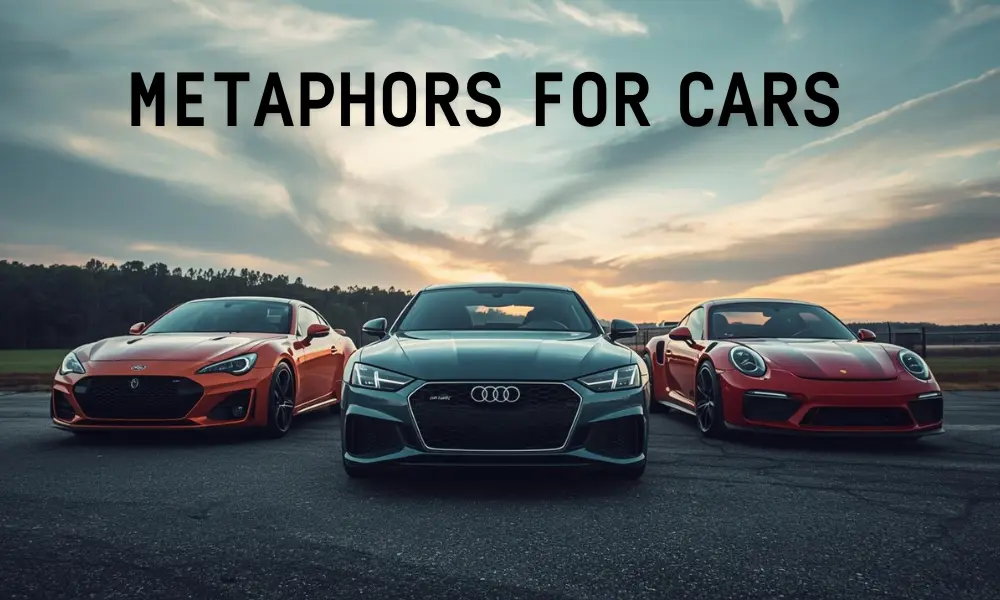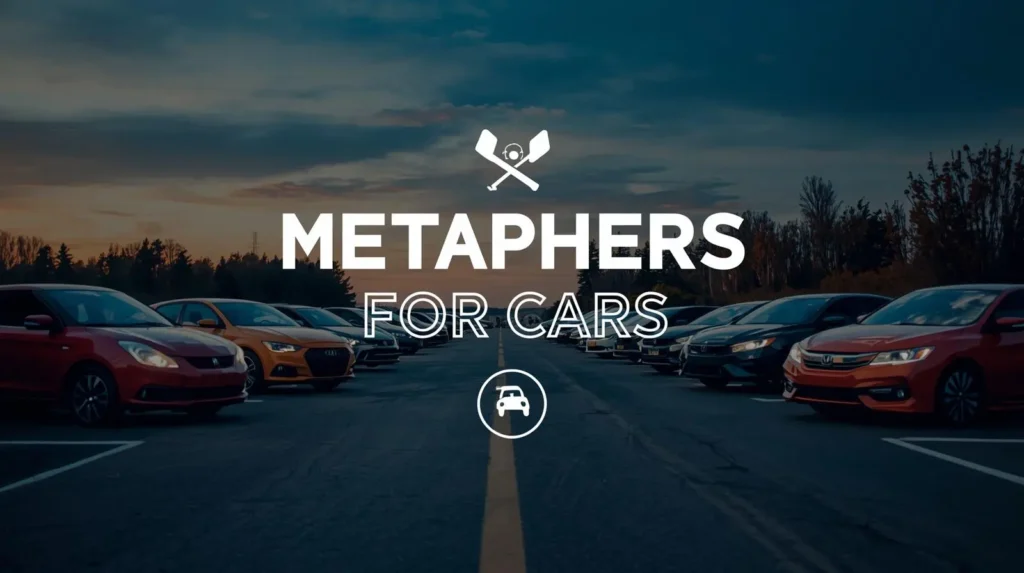Metaphors for Cars – Powerful Symbolism of Life, Freedom, and Journey

Cars aren’t just machines that take us from one place to another but they’ve long served as powerful metaphors for life, emotions, and personal journeys. Phrases like “running on empty” to describe exhaustion or “hitting the brakes” to mean slowing down a project show how naturally we use car-related language to explain complex ideas. A car can symbolize freedom, control, direction, or even a reflection of our inner state. Just as a well-maintained vehicle runs smoothly, so too can our lives when cared for properly.
What Are Metaphors for Cars?
Metaphors for cars are creative expressions where cars and their parts are used to symbolize human experiences, emotions, or life situations. Instead of talking literally about vehicles, these comparisons help us explain abstract or complex ideas in simple, relatable ways. For example, saying someone is “in the driver’s seat” means they are in control, while “stalled out” suggests being stuck or unable to move forward. Car metaphors connect the familiar world of driving with the challenges and journeys of everyday life, making language more vivid and meaningful.

Everyday Metaphors for Cars
- Running on Empty – Feeling exhausted or drained.
Example: After working overtime all week, I’m running on empty. - In the Driver’s Seat – Being in control of a situation.
Example: With her promotion, she’s finally in the driver’s seat at work. - Hitting the Brakes – Slowing down or stopping progress.
Example: The company hit the brakes on the project due to budget cuts. - Stuck in Neutral – Making no progress.
Example: My career feels stuck in neutral right now. - Shifting Gears – Changing direction or focus.
Example: After years in teaching, he shifted gears into business. - Overdrive – Working at maximum effort.
Example: We’re in overdrive trying to meet the deadline. - Out of Gas – Having no energy left.
Example: I wanted to keep going, but I was out of gas. - Flat Tire – A setback or problem that slows progress.
Example: That bad grade was a real flat tire for his confidence. - Wheels Turning – Thinking or processing ideas.
Example: You can see the wheels turning in her mind during the test. - Stalled Out – Stuck or unable to move forward.
Example: His career stalled out after the scandal. - Full Throttle – Giving maximum effort or energy.
Example: She went full throttle into her new business venture. - Roadblock – An obstacle preventing progress.
Example: Lack of funding became a roadblock to the project. - Accelerating – Picking up speed or making progress quickly.
Example: Sales are accelerating this quarter. - Breakdown – A collapse in health, emotions, or systems.
Example: She had a breakdown after months of stress. - Backseat Driver – Someone giving unwanted advice.
Example: He’s such a backseat driver when I’m cooking dinner. - Pedal to the Metal – Pushing to the limit.
Example: We’ve got to put the pedal to the metal to finish on time. - Long Road Ahead – A difficult journey still to come.
Example: Recovery is possible, but he has a long road ahead. - Bumpy Ride – Experiencing difficulties along the way.
Example: Starting a new business is always a bumpy ride. - Well-Oiled Machine – Something running smoothly.
Example: The team works like a well-oiled machine. - Skidding Off Track – Losing direction or control.
Example: The conversation skidded off track. - Revving Up – Preparing for action.
Example: The team is revving up for the big match. - Hitting the Road – Leaving or starting a journey.
Example: We’re hitting the road early tomorrow. - Crash and Burn – Failing suddenly and completely.
Example: His business idea crashed and burned. - Fast Lane – Living a high-energy, risky lifestyle.
Example: He enjoys life in the fast lane. - Test Drive – Trying something out temporarily.
Example: I’m just taking the new role for a test drive. - Detour – An unexpected change in plans.
Example: Life took a detour when she moved abroad. - On Cruise Control – Doing something with little effort.
Example: After years of practice, she’s on cruise control at work. - Fueling Up – Gaining energy or preparing.
Example: I need to fuel up with coffee before class. - Rusty Engine – Out of practice or slow to start.
Example: My math skills are like a rusty engine. - Horn Blowing – Drawing attention or boasting.
Example: He’s always blowing his horn about his success. - Green Light – Permission to proceed.
Example: The boss gave us the green light for the project. - Red Light – A signal to stop.
Example: Budget cuts put a red light on hiring. - Junkyard – Something discarded or useless.
Example: Don’t throw your dreams in the junkyard yet. - Highway Robbery – Being overcharged.
Example: That restaurant’s prices were highway robbery. - Crossroads – A point of important decision.
Example: She’s at a crossroads in her career. - Road Map – A guide or plan.
Example: We need a road map to reach our goals. Broke - Down on the Road – Being unable to continue.
Example: His plans broke down on the road to success. - Steering Clear – Avoiding something.
Example: She’s steering clear of office drama. - Tailspin – A situation out of control.
Example: His life went into a tailspin after losing his job. - Open Road – Freedom or opportunity.
Example: After retirement, she felt the open road calling.
Cultural & Literary Metaphors for Cars
- The Great American Road – Symbol of freedom and exploration.
Example: In American literature, the open highway often represents the pursuit of dreams. - The Tin Lizzie – Ford Model T as a metaphor for progress and industrial change. Example: In history books, the Tin Lizzie is the car that put the world on wheels.
- Chariot of the Modern Age – Car as a modern equivalent of ancient chariots.
Example: Writers describe cars as chariots carrying us into new eras. - Freedom Machine – Symbolizing independence and escape.
Example: For many teenagers, their first car is a freedom machine. - Rolling Coffin – A car as a dangerous object.
Example: In war literature, trucks were often called rolling coffins. - Steel Horse – Motorcycles or cars as the replacement for horses.
Example: Cowboys of the West now ride steel horses on highways. - Urban Chariot – Cars as symbols of status in cities.
Example: The luxury sedan is often described as the urban chariot of the wealthy. - The Dream Machine – Cars as symbols of aspiration.
Example: Advertisements often call sports cars the dream machine. - The Coffin on Wheels – Dark metaphor for unsafe vehicles.
Example: Old jalopies were often called coffins on wheels in novels. - Automobile as Identity – Car as a reflection of personality.
Example: In literature, the type of car a character drives often symbolizes their inner self.
Read: Metaphors for Hand
Creative & Modern Metaphors for Cars
- Smartphone on Wheels – Modern cars as tech hubs.
Example: With all its apps, the Tesla feels like a smartphone on wheels. - Data Highway Vehicle – Car as part of the digital network.
Example: Self-driving cars are data highway vehicles of the future. - Eco-Chariot – Electric cars as green transportation.
Example: His EV is his eco-chariot to a cleaner world. - Moving Office – Car as a workplace.
Example: With Bluetooth and Wi-Fi, my SUV is a moving office. - Battery-Driven Heart – Electric car as life fueled by energy.
Example: The EV’s battery is like its beating heart. - Silent Rocket – Electric cars as fast but quiet.
Example: The Tesla launches like a silent rocket. - Four-Wheeled Sanctuary – Car as a personal safe space.
Example: My car is my four-wheeled sanctuary after work. - Metallic Companion – Car as a loyal partner.
Example: After 15 years, my old hatchback feels like a metallic companion. - Digital Carriage – Tech-based car as modern luxury.
Example: That self-driving limo was a digital carriage. - AI Chauffeur – Self-driving technology as a metaphorical driver.
Example: Autonomous cars are your AI chauffeur of tomorrow.

Synonyms of Cars
| Synonym | Meaning |
|---|---|
| Automobile | The formal term for a motor vehicle designed for road transport. |
| Vehicle | A general term for any transport machine, including cars, trucks, and buses. |
| Motorcar | A traditional word for a passenger car, often used in British English. |
| Sedan | A specific type of car with four doors and a closed body style. |
| Coupe | A compact car, usually with two doors and a sporty design. |
| Hatchback | A small car with a rear door that swings upward for cargo access. |
| SUV (Sport Utility Vehicle) | A larger car designed for both urban driving and off-road use. |
| Convertible | A stylish car with a roof that can be folded down or removed. |
| Roadster | A lightweight, two-seater car, often sporty and open-topped. |
| Wheels | A casual or slang term for a car, emphasizing personal ownership and style. |
How to Use Cars Metaphors in Writing & Speaking
- Match the Metaphor to the Mood – Use energetic car metaphors (“pedal to the metal”) in motivational talks, and calmer ones (“cruise control”) when describing steady progress.
- Highlight Human Experiences – Compare emotions or behaviors to car functions (“he stalled out during the presentation”) to make abstract feelings relatable.
- Adapt to Context – In business writing, use car metaphors like “roadmap” or “shifting gears” to explain plans and strategies. In personal stories, “bumpy ride” or “running on empty” can add warmth and relatability.
- Blend with Modern Themes – Use updated car metaphors (“smartphone on wheels,” “AI chauffeur”) when discussing technology or innovation to connect with today’s audience.
- Keep It Visual – Choose metaphors that create strong imagery (“open road ahead,” “tailspin,” “revving up”), so readers or listeners can instantly picture what you mean.
Read: Metaphors for Nature
Read: Metaphors for Birds
FAQs
Conclusion
Cars are more than just vehicles; they are mirrors of our lives, emotions, and journeys. Through metaphors, cars become symbols of freedom, struggle, ambition, and identity. From everyday expressions like “running on empty” to modern comparisons like “AI chauffeur”, these metaphors simplify complex ideas and make communication richer and more relatable. Whether you’re writing creatively, giving a speech, or simply trying to express yourself, car metaphors provide powerful imagery that resonates with everyone. Just like cars take us places, car metaphors take our language on a meaningful ride.
